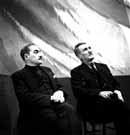
|
|
|

|

|

|

|
|
Click on an image to see a larger, more detailed picture.
|
|
|
|
|
| 1943: Death and Resistance |

|
pg. 411 |

|
|
|
|
| |
 Pictured with French collaborator Marcel Déat is Joseph Darnand (right), one of the most hated of the French collaborators. Darnand led a French military organization that openly fought for the Germans. As head of the Legionnaire Law and Order Service (SOL), Darnand was responsible for security operations throughout Vichy France. The SOL tracked down and brutally tortured members of the French Resistance. When France was liberated in 1944, Darnand and 6000 followers fled to Germany.
Pictured with French collaborator Marcel Déat is Joseph Darnand (right), one of the most hated of the French collaborators. Darnand led a French military organization that openly fought for the Germans. As head of the Legionnaire Law and Order Service (SOL), Darnand was responsible for security operations throughout Vichy France. The SOL tracked down and brutally tortured members of the French Resistance. When France was liberated in 1944, Darnand and 6000 followers fled to Germany.
Photo: Zucca/BHVP - Biblio. Hist. de la Ville de Paris
|
 Doctors and nurses examine an infant refugee from Europe in the offices of the World International Zionist Organization in Tel Aviv, Palestine. Despite British efforts to limit Jewish immigration to Palestine, Jewish refugees steadily streamed into the region throughout 1943--many illegally.
Doctors and nurses examine an infant refugee from Europe in the offices of the World International Zionist Organization in Tel Aviv, Palestine. Despite British efforts to limit Jewish immigration to Palestine, Jewish refugees steadily streamed into the region throughout 1943--many illegally.
Photo: Central Zionist Archives / United States Holocaust Memorial Museum Photo Archive
|
|
Choiceless Choices "One wants to live," wrote Salmen Lewental. Those words are part of a notebook buried and found near the ruins of Birkenau's crematorium III. Selected for labor when he entered Auschwitz on December 10, 1942, Lewental was put in the Sonderkommando a month later and condemned to work in the gas chambers and crematoria. He lasted long enough to join the Sonderkommando uprising on October 7, 1944. The date of his death is unknown. At one point in Lewental's notebook, he imagines someone asking him, "Why do you do such ignoble work?" Beyond answering that "one wants to live," there is no good reply, for what good choices did Lewental have? Nazi power repeatedly forced defenseless people to make what Holocaust scholar Lawrence L. Langer calls "choiceless choices." Such choices, he says, do not "reflect options between life and death, but between one form of 'abnormal' response and another, both imposed by a situation that was in no way of the victim's own choosing." Such was Lewental's miserable situation. He did not volunteer for the Sonderkommando any more than he chose deportation. Lewental was like millions of Holocaust victims. In Auschwitz his "choices"--dying by suicide, dying by resisting, or dying as a Sonderkommando--were essentially "choiceless."
|
|

|

|

|

|
 January 1943: Germans murder 61,000 Jews at Auschwitz, Treblinka, and Belzec during this month alone.
January 1943: Germans murder 61,000 Jews at Auschwitz, Treblinka, and Belzec during this month alone.
|
 January 1943: The United States State Department, which knows much about the Holocaust, continues to block attempts to transfer Jewish children to America.
January 1943: The United States State Department, which knows much about the Holocaust, continues to block attempts to transfer Jewish children to America.
|
 January 1, 1943: Jews in the Netherlands are no longer allowed to have bank accounts. All Jewish money is put instead into a central account.
January 1, 1943: Jews in the Netherlands are no longer allowed to have bank accounts. All Jewish money is put instead into a central account.
|
 January 3, 1943: Polish President Wladyslaw Raczkiewicz requests that Pope Pius XII publicly denounce German atrocities against the Jews. Pius remains silent concerning both the German slaughter of the Polish Jews as well as the German attacks against Polish Catholics.
January 3, 1943: Polish President Wladyslaw Raczkiewicz requests that Pope Pius XII publicly denounce German atrocities against the Jews. Pius remains silent concerning both the German slaughter of the Polish Jews as well as the German attacks against Polish Catholics.
|
 January 4, 1943: The SS administrative office instructs all concentration-camp commandants to send human hair taken from Jewish women to the firm of Alex Zink, Filzfabrik AG at Roth, Germany, near Nuremberg, for processing.
January 4, 1943: The SS administrative office instructs all concentration-camp commandants to send human hair taken from Jewish women to the firm of Alex Zink, Filzfabrik AG at Roth, Germany, near Nuremberg, for processing.
|
 January 4, 1943: Young members of the Jewish Fighting Organization are rounded up in Czestochowa, Poland. Its leader, Mendel Fiszlewicz, uses a hidden pistol to wound the German commander of the Aktion. Fiszlewicz and 25 other men are immediately shot, and 300 women and children from the group are deported to the Treblinka death camp and gassed.
January 4, 1943: Young members of the Jewish Fighting Organization are rounded up in Czestochowa, Poland. Its leader, Mendel Fiszlewicz, uses a hidden pistol to wound the German commander of the Aktion. Fiszlewicz and 25 other men are immediately shot, and 300 women and children from the group are deported to the Treblinka death camp and gassed.
|
|
|
|
|
| 1943: Death and Resistance |

|
pg. 411 |

|
|
The Holocaust Chronicle
© 2009 Publications International, Ltd.
|
|
